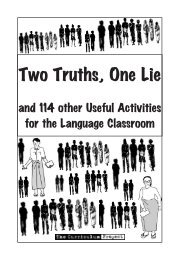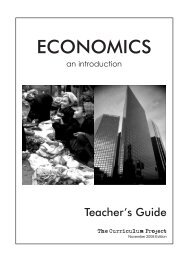Student's Book â Dec 2009 (5.9mb) - The Curriculum Project
Student's Book â Dec 2009 (5.9mb) - The Curriculum Project
Student's Book â Dec 2009 (5.9mb) - The Curriculum Project
You also want an ePaper? Increase the reach of your titles
YUMPU automatically turns print PDFs into web optimized ePapers that Google loves.
extensionChoose one of the following texts to read in groups. Explain your text to another group.restating1. Pre-Muslim IndonesiaWhen Funan fell under Khmer rule, other Southeast Asian states began to dominate the tradebetween India and China. <strong>The</strong> one in the best location was Srivijaya, on the southeastern coast ofSumatra near both the Malacca and Sunda Straits. Srivijaya not only ruled Sumatra but also theMalay peninsula and western Java. It had almost complete control over Indochina trade.2. Funan (fuh-nan)<strong>The</strong> lower Mekong valley was very fertile. Partly because of the water supply in Tonle SapLake, the area was, and still is, an excellent place to grow rice. Today, the area covers most ofCambodia and the southern part of Vietnam, but in the first century AD, the entire lower Mekongregion was united under the kingdom of Funan. Its port, called Oc-Eo (o-tse-o), was located inthe Mekong delta where the Mekong enters the Gulf of Thailand. It was a centre of commerce,with traders coming from China, India, and even Rome. Funan was a strong nation until 514 ADwhen the state was weakened by internal conflict and external threats.3. Mon and MalayTwo Mon states, named Dvaravati (dvah-rah-vah-ti) and Haripunjaya (hah-ri-phun-jahyah),were founded around 500 AD in central and northern Thailand. <strong>The</strong>y probably relied onagriculture since they did not have access to the sea. In the Malay Peninsula, several small statesappeared, stretched across the Isthmus of Kra in different locations. <strong>The</strong> Malay states prosperedby offering traders a route that was both quicker and safer than the Straits of Malacca.4. Burma<strong>The</strong> ancestors of today’s Burmese settled in Upper Burma around 500-200 BC. Most of theTibeto-Burman tribes marched over the mountains of Yunnan and northern Burma to reach theIrrawaddy valley. From there, the tribes spread out into surrounding areas. One of these werethe Pyus. <strong>The</strong>y prospered from the merchants who used the Ayeyarwaddy to go between Indiaand China. <strong>The</strong>y also got along well with the Mons of Thaton and with India. <strong>The</strong> Pyus governedeach tribe by democratic assembly. <strong>The</strong> power of the Pyu declined after the 8th century.In the 3 rd century, Arakanese people established a kingdom at Dhanyawadi on the coast, betweenthe Irrawaddy Delta and the border of modern Bangladesh. This city also became an importantcenter of trade with India.As Pyu power decreased, Burman power increased. When Thais attacked the Pyu capital in 832AD, <strong>The</strong> Burmans built Pagan as their new capital. Around the same time, the Mons built Pegu, acity on the eastern edge of the Irrawaddy Delta.A powerful Burman king named Anawrahta (1044-1077 AD) was responsible for conquering theterritory that is modern day Burma.5. Vietnam<strong>The</strong> origin of the Vietnamese people is uncertain. <strong>The</strong>ir language is very similar to the Mon-Khmer languages and also to Thai and Malay. <strong>The</strong> Vietnamese themselves claim that theirancestor is one of China’s first kings. Historians believe that the Viets migrated to the southescaping the Chinese in the 4 th century BC. Some Viets settled in Fujian Province and the restcontinued to the Red River delta. <strong>The</strong>y intermarried with the people already living there, andformed the ethnic Vietnamese of today.<strong>The</strong> area now known as Vietnam was conquered by the Chinese in 111 BC and has beeninfluenced by Chinese ideas and culture ever since. <strong>The</strong> Chinese were driven out in 939 AD.22













![[Eng] Nov 2012 DRAFT - The Curriculum Project](https://img.yumpu.com/45590859/1/184x260/eng-nov-2012-draft-the-curriculum-project.jpg?quality=85)


